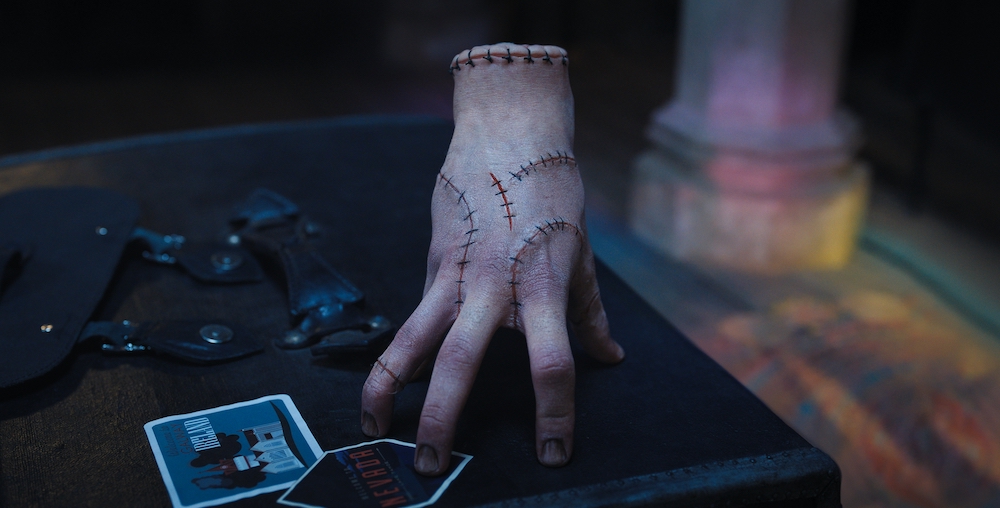
In the mind of Wednesday director Tim Burton, thee’s a strong desire to look as humanly real as possible, even when your characters are demons, monsters, and, of course, Thing. Working with actors to facilitate the visual effects is VFX Supervisor Tom Turnbull, who, together with the unique artistry of Burton brought the dark netherworld of the Addams family to life. Morticia, Gomez, Uncle Fester, Pugsley, Wednesday, Lurch, and, of course, Thing returned with a gothic bang.
The eight-episode Netflix series, which premiered in November 2022, is the coming-of-age story of Wednesday Addams (Jenna Ortega), who gets expelled from school after dumping live piranhas into the pool. When Morticia and Gomez enroll her at their high school alma mater, Nevermore Academy, a private school for monstrous outcasts, her supernatural adventures unfold, involving a local murder mystery.
Toronto-based Turnball and his Rocket Science VFX team have done visual effects for such TV series as Hell on Wheels, Alias Grace, The Boys, Locke & Key, Into the Badlands, and Trickster. He was the visual effects supervisor for such films as Greta, The Nest, and Crimes of the Future. For Wednesday, Turnball turned to his fearless leader, Tim Burton, who had very specific ideas about what he wanted the visual effects to look like, and “CGI” was essentially a dirty word. For Turnball, the task at hand, pun intended, required an actor who had the dexterity and, yes, the emotional depth to portray Thing, which he found in Romanian magician Victor Dorobantu.
Below the Line spoke with Tom Turnball via Zoom video while he was home in Toronto. A wonderful storyteller who says he can go on for days, but in our limited conversation he reveals what was behind the macabre creations on Wednesday.
[Note: This interview has been edited for clarity and length]
Below The Line: What was it like working in Romania for Wednesday?

Tom Turnball: I was in Romania for seven months. Honestly, I really enjoyed working in Romania. We had an old Soviet-era film studio that was now in private hands. It was in bad disrepair when we arrived there, but it had an enormous amount of facilities for us in one concentrated area. We had four big stages. A hundred hundred yards from my office, we had a forest outback, which is a two-minute walk from where everybody was. We had a back lot just five minutes up the road. We had an old New England set that we repurposed to turn into Pilgrim World. When we did underwater shooting, there was literally a water tank outside my office.
The resources we had shooting in Romania at that particular studio at that particular time far exceeded what you would normally expect. The number of times we actually had to go on the road to a location was very few, so much of it was right there. Because it had just been put into private hands, we pretty much had a free-for-all. It was very flexible, but when we arrived, it looked like Chernobyl. There were packs of dogs, some wild, that were running around.
BTL: Let’s talk about Thing. What it was like working with a human being behind the hand? What did that bring to the table?
Turnball: We cast pretty broadly to try and find somebody to play Thing who would have the correct attributes we needed to do it. I was part of the casting process, which is not normal. Clearly, they had to have pretty great dexterity to have the right look. We didn’t want short, stubby fingers. We wanted this elongated finger, so there was sort of an elegance to him. Because we were going to be putting him in difficult positions, he needed to be somebody who was reasonably dextrous and pretty young. It had to be someone who understood performance.
The interesting thing is that when we went through all of the casting tapes, we ended up with a short list of three we thought were the strongest contenders that met our criteria, and they were all magicians, all three of them. In the original Addams family shows and the movies from the nineties, Christopher Hart, who played Thing, was also a magician and is still a magician. That’s what he does professionally. My feeling is that they work a lot with their hands, so they’re adept at it. I think they also understand performance and misdirection, which are huge components of doing magic. It’s doing something here while making people look there. That’s key to the way Thing’s performance needed to be. You had to not see the invisible person connected to the hand, right? So the performance had to stand on its own, and it had to be what you were looking at, regardless of everything going around.
BTL: Who did you ultimately find and how did he fit the bill?
Turnball: Tim chose him in the end out of the shortlist, and he was my favorite, so I was happy about that. It was Victor Dorobantu, a young Romanian guy. He knew what it was like to stand on stage as a magician, but he knew nothing about the filmmaking process or acting, so we kind of put him through bootcamp. We videoed him, and we did a mock-up shoot so he could understand how the process was going to work. We certainly brought him around and showed him all of the sets, how they were built, and where he was going to perform. We did everything we could to prepare him, working out ways to move, ways to walk, how to react, and how to communicate. We taught him American Sign Language, which he amazingly learned in a weekend.
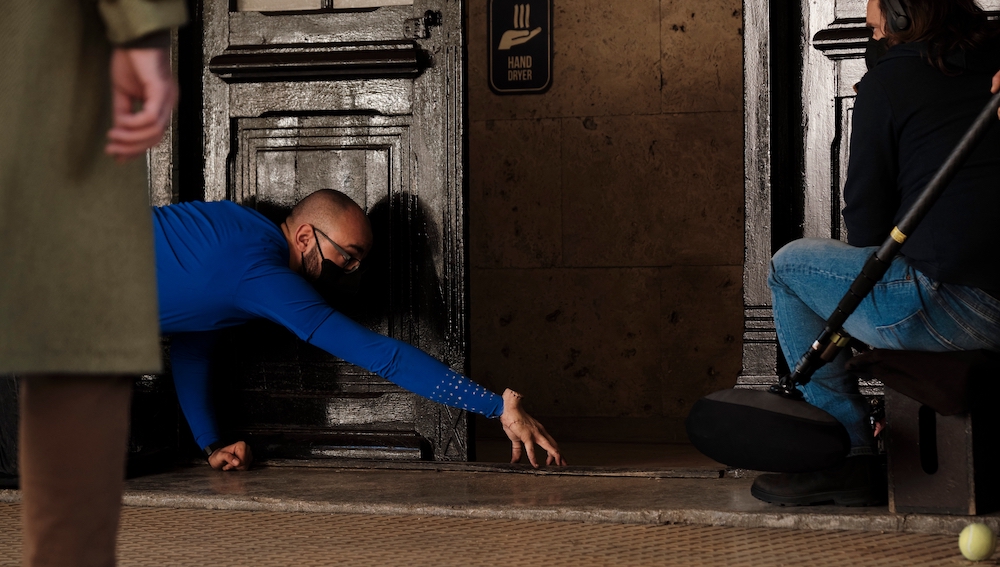
BTL: Was he ambidextrous, and would you say his training paid off in portraying Thing?
Turnball: He always used the same hand. He didn’t like switching hands. It was always his right hand. We never did any cheating like that. He is an actor now for sure, and his first day of actually professionally acting was on set with Tim Burton and Jenna Ortega, so I’m not sure how he psyched himself up for that, but he nailed it. He definitely worked out his own way of doing things.
BTL: How else did you try to help him on set?
When he was acting, we would give him monitors so he could watch what he was doing—like you do with puppeteers. That wasn’t very useful to him. He didn’t really find that helpful. What he did find helpful was having eye contact with the actor he was playing against and not looking at his hand when he was working. He’s looking into the actor’s eyes, and he’s communicating directly with them. He’s personifying what he would want to say with his hand.
I mean, we put him in a blue suit so that we knew what to paint out, but he also had a blue hood that he would also put on. He always put on his blue hood, even when he was off-set. We didn’t see his head because he never wanted the other actor to see him as a person. He wanted the other actor just to see him as this. They definitely wrote a full character for him; he’s not like a pet. Certainly, visual effects really kind of supported that. But really, Victor did that. It’s his performance, and he owns it.
BTL: What were some of those visual effects that supported Thing?
Turnball: The obvious one is the paint-outs that we had to do, but we also had to do a lot of pre-planning as much as we could of what we needed to provide on set for him to do his job. Sometimes he knew that he was going to be in a certain place, but in order for him to do the performance, we would have to make a hole in the wall for him to be behind or change the set in some fashion. We would prep all that stuff for him, and sometimes we would provide things on set to make it easier for him or cut away part of something.
For example, he does a scene on a bed, and we knew that with him acting on the bed and having to paint him out, there were going to be quite a few issues with that. So, we deliberately slipped under the covers a hard surface, so the bed wouldn’t have quite as much deflection, and that would enable him to do his performance and be an easier way to allow us to paint out the bits in a more usable way.
Another big part of what we provided for him is obviously reconstruction, because whenever he’s on set, there’s a lot of stuff that has to be painted back in. When you’re dealing with something like moving bedsheets, that’s a lot of work. There’s one scene there where his hand is crawling down a skeleton. His entire arm is covering up part of that skeleton, so having to reconstruct all of that to allow him to do the performance that he needs to do That’s what I mean by support.
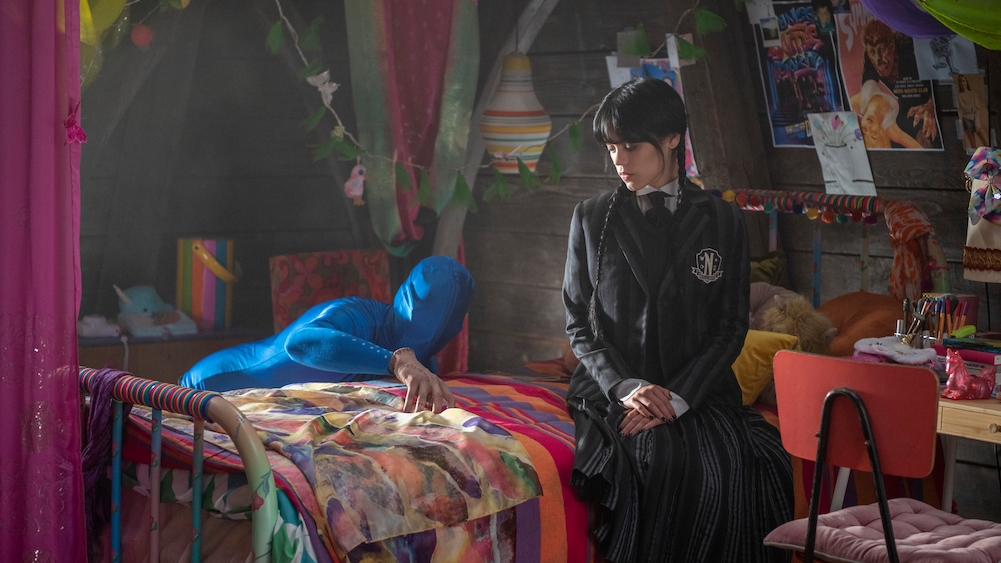
BTL: Let’s move on to the Hyde monster. Where’d your collaboration with Tim begin with that creature?
Turnball: One of the things I learned about Tim is that there are certain things that he cares very much about and other things that he doesn’t, and the Hyde was one of the things he cared very much about. He cared about Thing and how we did Thing, and he cared very much about the Hyde and the reason for that is to him a lot of these other creatures, werewolves, we’ve seen them before and we have a good understanding what a werewolf is. There’s tons of precedent and tons of ways and transitions that have been done.
Now, Tim took on board a lot of the design process on that. In the end, he actually did do a sketch of the creature, and that’s because the concept people were not really getting it. Once he did up his own sketch, and I don’t know if you know much about Tim, but he always carries with him a set of paints and ink set; that’s one of the ways he communicates. He did up that quick sketch. We sent that out to the concept people and immediately we got back results that were exactly what he was looking for. From that point, we knew the direction we had to go.
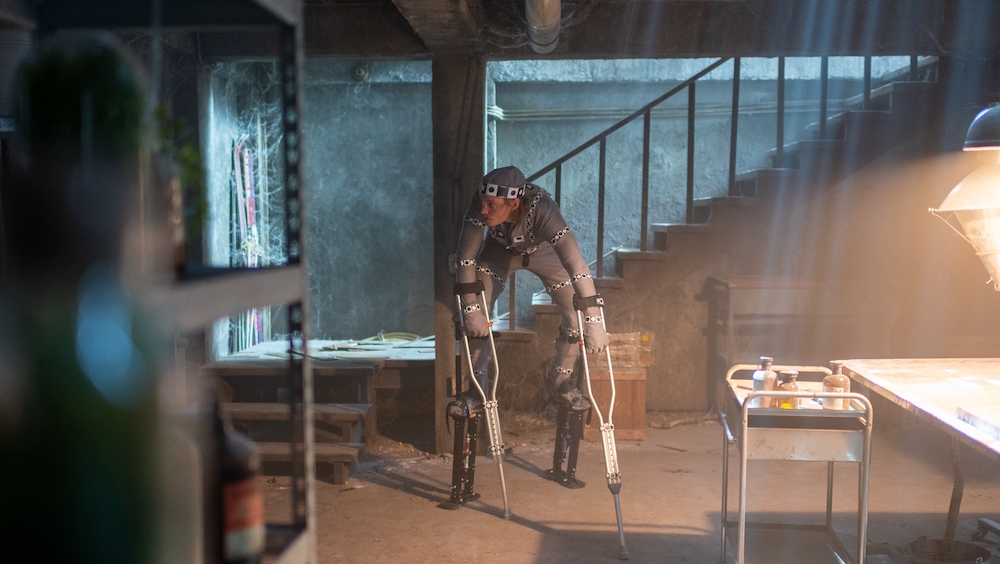
BTL: How did you animate Tim Burton’s sketch of the Hyde monster?
Turnball: Sort of leaning into the idea that we wanted to keep things as practical as possible, and obviously, in the case of Hyde, there was no real practical way to do him. He was going to be a fully CG character, so we wanted to build around that as much as we could. When the actors were interacting with Hyde, it wasn’t just somebody holding up a stick with a tennis ball on the end and saying, “Look, now Hyde is over here.” We wanted it to be much more immediate and interactive than that.
We got the stunt team, who helped us out by finding a good performer, and we put the guy on stilts to give him the height, and we gave him arm extensions to simulate the reach because Hyde has immensely long arms. He was there for all of the Hyde scenes. So whenever we blocked the shot with the director and shot it with the camera crew and did actual shots with the actors, he was always there to sort of provide that framework so that everybody could see something and understand what they were composing and how it would all go together.
Then, of course, that guy who put in all that work got painted out and replaced with CG Hyde. He is doing all of this stunt work that was completely left out of the movie. We had another actor play Enid the werewolf. The editor was able to put together a sequence using the stunt performers. It gave us the whole shape of the thing, and then we handed it off to MR. X VISUAL EFFECTS to put the creatures in. It made it more believable. It’s not just CG monsters throwing each other around.
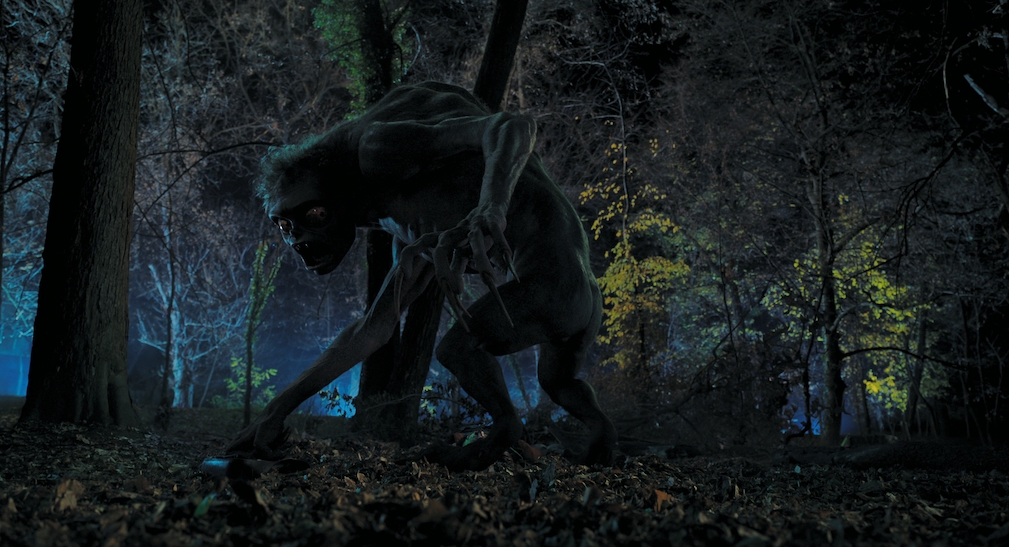
BTL: How did you make the charcoal drawing of the spider come to life?
Turnbull: You’ve asked a question that no one else has! Thank you. That was something that was in the script right from the get go. I pitched the idea of doing the drawing in such a way that we would find a point in the drawing where we would match perspective with a real 3D object. It’s a little bit of a trick that you sometimes see in a lot in commercials but you sometimes see it in other films.
It’s deliberately knowing where you want to do the transition and basing the sketch on that transition point so you can make those perspectives line up. I ended up doing a test to demonstrate this because nobody was understanding what I was talking about. (laughs) The test sold it. Once we showed we do it this way, we can make the transition happen almost invisibly, where at one point it’s a drawing and at one point it’s a 3D real spider thing on the page.
BTL: Did Tim also draw the spider?
Turnball: I don’t know that he actually did. I know that the props department hired an artist who ended up drawing an enormous number of spiders before Tim got one that he liked. That fell into the category of creatures that he was obviously interested in. That was part of the show, and he wanted to have his input on it, but he didn’t get bogged down in it. It’s slightly based on a black widow, but a larger version of it.
With a lot of the creatures, we did incorporate a black and red motif. You see that in the pirahnas, and you see that in the spider. Although, in the end, we don’t actually see the red on it because it’s on its back, those were colors that were important to the theme of the show. Those were kind of Wednesday’s colors, predominantly black with splashes of red. Wherever we could, we would tie it into the broader aesthetic of Wednesday’s world.
BTL: With the piranhas, what are the challenges of doing visual effects with water?
Turnball: From a design point of view, we started with very realistic piranhas. We show those concepts to Tim, and in Tim’s way of doing things, he likes his creatures to be real. They should be believably real, but slightly changed so that they’re not anything that is truly real. Wen we gave him the piranha fish concepts, Tim just made a few small changes, and most of it was enhancing the jaws a little bit.
When we shot in the pool, we had an underwater camera that was brought in for the day, and it was really last minute, so we didn’t really have much chance to vet it, so we just got what we got with it. I have to say that, when we did water work later on, we were much more thorough because we had much more time to plan. This was very early in the schedule, and for the post-house folks, we really didn’t do them any favors. We kind of gave them these underwater plates with not a lot of good information about the lensing or the port that was on the camera. They didn’t have much to go on, so a lot of it fell to them to figure it out, and they did a great job. I’m certain there were a whole bunch of cheats they did in there, but I don’t really want to know what they were.
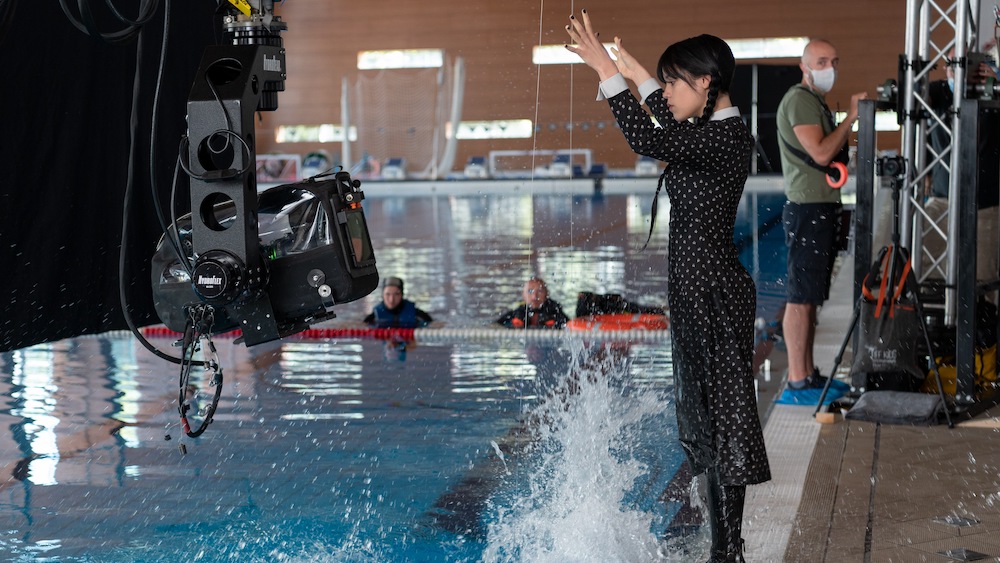
BTL: The effects in the show are great, so congratulations on all you work. In your wildest dreams, where would you like to take Thing in season two?
Turnball: Well, I can’t talk a lot about season two for obvious reasons. It’s still very much in the creative shaping stage. Tim definitely wanted to make Thing as much of a human performance as possible, and Tim was good at leaning into the limitations because there are some severe limitations to doing it practically. Going into the show, my firm belief was that we should do as much as we can practically, but we’re going to have to fall back a lot on 3D because the limitations are steep. You can only shoot from this angle because otherwise Victor’s body blocks the actors. He can only turn so much and only reach so much. Tim, with his experience, was aware of all of that, and he kind of leaned into it. He never put Victor in a position where he couldn’t do it.
BTL: So, without spoiling anything or speaking out of school, where do you and Victor want to go from here with Thing?
Turnball: I want to take things to a higher level. I want Thing to do more, get more out of Victor’s performance, and give him more flexibility to do things. Some of the creature work is definitely something I want to elevate further, too. In season two, we’re going to have space to do that. Having gone through the process now, it’s a constant learning curve when you do something, and it’s like, “Yes, now we can do that better if we do this.” Those are two areas where I’d want to raise the bar a little higher. I don’t think we’re anywhere near finished with what Thing can do.
There are a lot of things we haven’t seen Thing do that we now have to figure out. We should figure out how he does it, and we should try to incorporate it. We’ve never seen him climb a staircase. Does he have to leap from step to step? Is there a way to crawl up? We don’t know these things yet, so there’s lots we can work on, but it really comes down to whether I want to give him and Thing more freedom.
Wednesday is now available to stream on Netflix.





